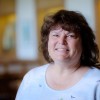This article is more than 5 years old.
This morning I had another opportunity to browse the exhibits. Either I’m getting bolder or they were giving more “stuff” away as I managed to pick up some more bags and books. I also checked out the Summons product from Serial Solutions to see if it could help in ILL. Since she does most of the lending, I’m quite sure Cristina will want to look at it when she returns. Next I took a shuttle up State St. for lunch to escape the captive market lunch prices at McCormick Place.
After lunch I attended a technology session called “Has Library 2.0 Fulfilled its Promise?”. One of the panelists admitted that Library 2.0 hadn’t “promised” anything but he thought it was a catchy title. The panelists were Meredith Farkas, Cindi Trainor, David Lee King and Michael Porter(aka Libraryman). Starting with a question of how they would define Library 2.0 panelists suggested it is a space that ‘invites collaboration” and is “user focused”. Michael Porter said that users of Lib 2.0 care more about functionality than brand names.
While this was supposed to be a lively discussion of opposing voices, there was little dissent among the panelist when they were asked what qualifies as a Library 2.0 technology.Meredith Farkas suggested that it was technology that builds community. David Lee King emphasized that it needs to be technology that is understandable to the non-professional users. Cindi Trainor pointed out that all those who work in libraries are empowered to engage in sharing with Library 2.0 technology.
Barriers that were identified included faculty and staff that are reluctant to learn these tools, lack of time to learn how to use them, a lack of people that are willing/able to be in charge of the use of the applications, and administration that does not value the use of the tools enough to allot time to learn them.
At the end of the panel discussion the panelists were asked to emphasize one point each. David Lee King encouraged library managers to let their staff”go with it”. He suggested that failures would still be educational. Meredith Farkas reminded us that these technologies are not a”magic wand”. If a technology does not fit the culture of your library, stick with what works. Michael Porter said the library should focus on their present mission but look at it in light of new technologies. Cindi Trainor recommended a program such as “23 Things” to help library staff become aware of the options available. (I was instrumental in adapting this program for the PCL. While the program fizzled, I learned a LOT while setting it up.)
After the program ended I visited Grant Park and the silver bean. The evening was finished off with fish & chips at the Emerald Loop Bar & Grill and a visit to Ghirardelli’s by Water Tower Place.
